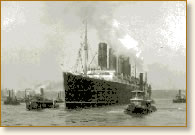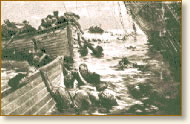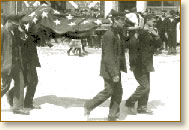The Sinking of the Lusitania
The Lusitania made her maiden voyage from Liverpool to New York in September
1907. Construction had begun in 1903 with the goal of building the fastest liner
afloat. Her engines produced 68,000-horse power and pushed the giant through
the water at an
 |
The Lusitania leaves New York
May 1, 1915 |
average speed over 25 knots. Dubbed the "Greyhound of the Seas" she soon captured the Blue Ribbon for the fastest Atlantic crossing.
The British Admiralty had secretly subsidized her construction and she was built to Admiralty specifications with the understanding that at the outbreak of war the ship would be consigned to government service. As war clouds gathered in 1913, the Lusitania quietly entered dry dock in Liverpool and was fitted for war service. This included the installation of ammunition magazines and gun mounts on her decks. The mounts, concealed under the teak deck, were ready for the addition of the guns when needed.
On May 1, 1915, the ship departed New York City bound for Liverpool. Unknown
to her passengers but probably no secret to the Germans, almost all her hidden
cargo consisted of munitions and contraband destined for the British war effort.
As the fastest ship afloat, the luxurious liner felt secure in the belief she
could easily outdistance any submarine. Nonetheless, the menace of submarine
attack reduced her passenger list to only half her capacity.
 |
A contemporary illustration
of the sinking |
On May 7, the ship neared the coast of Ireland. At 2:10 in the afternoon a torpedo fired by the German submarine U 20 slammed into her side. A mysterious second explosion ripped the liner apart. Chaos reigned. The ship listed so badly and quickly that lifeboats crashed into passengers crowded on deck, or dumped their loads into the water. Most passengers never had a chance. Within 18 minutes the giant ship slipped beneath the sea. One thousand one hundred nineteen of the 1,924 aboard died. The dead included 114 Americans.
Walter Schwieger was captain of the U-Boat that sank the Lusitania. He
watched through his periscope as the torpedo exploded and noted the result in
his log, "The ship stops immediately and heals over to starboard quickly, immersing simultaneously at the bow. It appears as if the ship were going to capsize very shortly. Great confusion is rife on board; the boats are made ready and some of them lowered into the water. In connection therewith great panic must have reigned; some boats, full to capacity are rushed from above, touch the water with either stem or stern first and founder immediately."
 |
An American victim is buried
in Queenstown (Cobh), Ireland
May 25, 1915 |
In the ship's nursery Alfred Vanderbilt, one of the world's richest men, and playwright Carl Frohman tied life jackets to wicker "Moses baskets" holding
infants in an attempt to save them from going down with the ship. The rising
water carried the baskets off the ship but none survived the turbulence created
as the ship sank to the bottom. The sea also claimed Vanderbilt and Frohman.
The sinking enraged American public opinion. The political fallout was immediate. President Wilson protested strongly to the Germans. Secretary of State William Jennings Bryan, a pacifist, resigned. In September, the Germans announced that passenger ships would be sunk only with prior warning and appropriate safeguards for passengers. However, the seeds of American animosity towards Germany were sown. Within two years America declared war.
References:
Simpson, Colin, The Lusitania (1972); Hickey, Des & Smith, Gus, Seven Days to Disaster (1982).
How To Cite This Article:
"The Sinking of the Lusitania,1915," EyeWitness to History, www.eyewitnesstohistory.com (2000).
|






